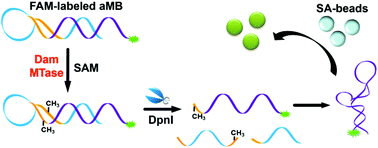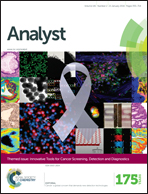Detection of DNA methyltransferase activity using allosteric molecular beacons
Abstract
Abnormal DNA methylation patterns caused by altered DNA methyltransferase (MTase) activity are closely associated with cancer. Herein, using DNA adenine methylation methyltransferase (Dam MTase) as a model analyte, we designed an allosteric molecular beacon (aMB) for sensitive detection of Dam MTase activity. When the specific site in an aMB is methylated by Dam MTase, the probe can be cut by the restriction nuclease DpnI to release a fluorophore labeled aptamer specific for streptavidin (SA) which will bind to SA beads to generate highly fluorescent beads for easy signal readout by a microscope or flow cytometer. However, aMBs maintain a hairpin structure without the binding ability to SA beads in the absence of Dam MTase, leading to weakly fluorescent SA beads. Unlike the existing signal amplified assays, our method is simpler and more convenient. The high performance of the aptamer and the easy bead separation process make this probe superior to other methods for the detection of MTase in complex biological systems. Overall, the proposed method with a detection limit of 0.57 U mL−1 for Dam MTase shows great potential for further applications in the detection of other MTases, screening of MTase inhibitors, and early diagnosis of cancer.

- This article is part of the themed collection: Innovative Tools for Cancer Screening, Detection and Diagnostics

 Please wait while we load your content...
Please wait while we load your content...